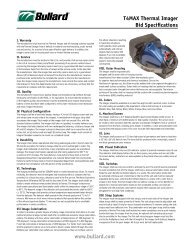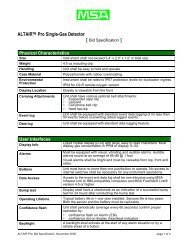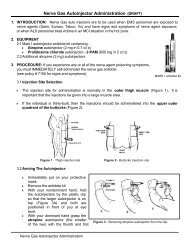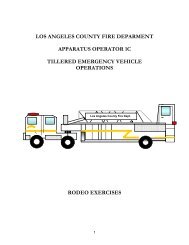Rope Life - New York Search & Rescue
Rope Life - New York Search & Rescue
Rope Life - New York Search & Rescue
You also want an ePaper? Increase the reach of your titles
YUMPU automatically turns print PDFs into web optimized ePapers that Google loves.
Section 5.2.2 of ASTM F 1740 - 96 Guide for Inspection of Nylon, Polyester, or<br />
Nylon/Polyester Blend, or Both Kernmantle <strong>Rope</strong>, recommends ten years as a maximum<br />
rope life. How a rope is used and stored has a greater effect on rope life than any other<br />
factor.<br />
In June of 1992, National City (CA) Fire Department sent us a rope they described as old<br />
and well used. It was the worst looking of the ropes they had in service and its acquisition<br />
preceded any record keeping. The marker tape indicated the rope was BlueWater II<br />
manufactured in 1983. BlueWater's catalog specifies a 7,600 pound (34.06 kN) tensile<br />
strength for 1/2 inch (12.7 mm) diameter BlueWater II. Tested by Wellington<br />
Commercial Cordage, the results showed an approximate 15% strength loss after nearly<br />
10 years.<br />
Break #1 ................................ 6,400 pounds (28.69 kN)<br />
Break #2 ................................ 6,800 pounds (30.48 kN)<br />
Average ................................. 6,600 pounds (29.58 kN)<br />
Bruce Smith, co-author of On <strong>Rope</strong>, collected and broke over 100 samples of used caving<br />
rope. Using each rope's history, each sample was categorized as "like new", "used", or<br />
"abused". Like new ropes averaged a strength loss of 1.5 to 2 percent per year, and used<br />
ropes 3 to 4 percent per year. Smith observed that "care of the rope has a far greater<br />
impact on a rope's life than age." 2<br />
At this time the evidence suggests that with average use a rescue rope will lose 1.5 to 2<br />
percent of its strength per year. Under hard use, a rope can lose 3 to 5 percent per year.<br />
Once you decide the minimum strength for your lifeline, you can calculate the expected<br />
service life.<br />
Aside from shelf life and strength loss, the other reason for retirement is damage, or<br />
suspected damage. The inspection may find evidence of damage, or a team member may<br />
report that the rope suffered an impact load, was hit by a rock, or smashed between the<br />
stretcher and the wall. If you do decide to retire the rope, take it apart and look inside at<br />
the damaged area to get a better understanding of how much abuse the sheath can take<br />
and still protect the core. More often than not, no damage to the core can be seen.<br />
Again, if you have any doubt about the integrity of your lifeline, retire it. <strong>Rope</strong> is just not<br />
expensive enough to risk a rescuer's life over.<br />
! November 1998, CMC <strong>Rescue</strong>, Inc.<br />
1 Ellis, J. Nigel. Introduction to Fall Safety. Des Plaines, IL: American Society of Safety Engineers; 1998.<br />
2 Smith, Bruce. "Aging <strong>Rope</strong>." Nylon Highway. Issue No. 25. Huntsville, AL: Vertical Section, National<br />
Speleological Society; January, 1988.<br />
CMC <strong>Rescue</strong>, Inc., PO Box 6870, Santa Barbara, CA 93160 (805) 562-9860
















